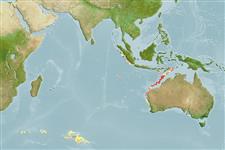Myxini (hagfishes) >
Myxiniformes (Hagfishes) >
Myxinidae (Hagfishes) > Eptatretinae
Etymology: Eptatretus: hepta (Gr.), seven; tretos (Gr.), perforated (i.e., with holes), referring to seven gill apertures on what would later be described as Homea banksii (=E. cirrhatus) [range within genus is 6-14 pairs of gill apertures]. (See ETYFish); alastairi: In honor of Alastair Graham (b. 1964), Fish Collection Manager, CSIRO (Commonwealth Scientific and Industrial Research Organisation), Canberra, Australia, for help and hospitality offered to second author. (See ETYFish).
Environment: milieu / climate zone / depth range / distribution range
Ecology
Marine; bathydemersal; depth range 380 - 550 m (Ref. 85052). Tropical
Eastern Indian Ocean: Western Australia.
Size / Weight / Age
Maturity: Lm ? range ? - ? cm
Max length : 49.5 cm TL male/unsexed; (Ref. 85052)
Short description
Morphology | Morphometrics
This species differs from all its congeners except for the western Atlantic species (E. mendozai, E. minor and E. multidens) by possessing 6 pairs of gill pouches and three-cusp multicusps on the anterior and posterior rows of cusps. It differs from E. mendozai in number of total cusps (48-56 vs. 56-61), trunk pores (50-55 vs. 48-48) and total pores (83-88 vs. 77-82; from E. minor in number of prebranchial pores (13-16 vs. 15-18), trunk pores (50-55 vs. 41-48) and total pores (83-88 vs. 74-82); and from E. multidens by its number of tail pores (11-13 vs. 15-16) and total pores (83-88 vs. 88-93) (Ref. 85052).
Iteroparous (Ref. 94918).
Life cycle and mating behavior
Maturity | Reproduction | Spawning | Eggs | Fecundity | Larvae
Iteroparous (Ref. 94918).
Mincarone, M.M. and B. Fernholm, 2010. Review of the Australian hagfishes with description of two new species of Eptatretus (Myxinidae). J. Fish Biol. 77(4):779-801. (Ref. 85052)
IUCN Red List Status (Ref. 130435)
Threat to humans
Harmless
Human uses
More information
Age/SizeGrowthLength-weightLength-lengthLength-frequenciesMorphometricsMorphologyLarvaeLarval dynamicsRecruitmentAbundanceBRUVS
ReferencesAquacultureAquaculture profileStrainsGeneticsElectrophoresesHeritabilityDiseasesProcessingNutrientsMass conversion
Tools
Special reports
Download XML
Internet sources
Estimates based on models
Preferred temperature (Ref.
123201): 1.3 - 10.6, mean 5.3 °C (based on 12 cells).
Phylogenetic diversity index (Ref.
82804): PD
50 = 0.5000 [Uniqueness, from 0.5 = low to 2.0 = high].
Bayesian length-weight: a=0.00204 (0.00092 - 0.00452), b=2.93 (2.73 - 3.13), in cm total length, based on LWR estimates for this (Sub)family-body shape (Ref.
93245).
Trophic level (Ref.
69278): 4.2 ±0.7 se; based on size and trophs of closest relatives
Fishing Vulnerability (Ref.
59153): Moderate vulnerability (40 of 100).
